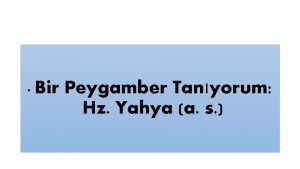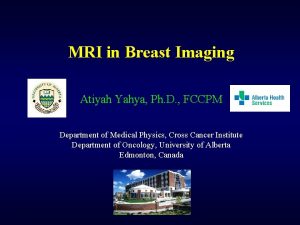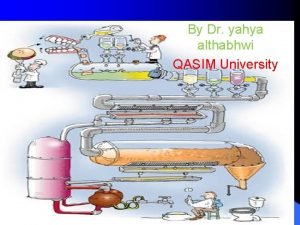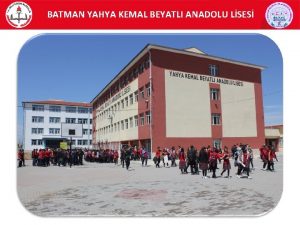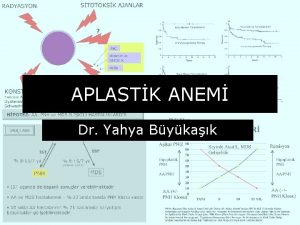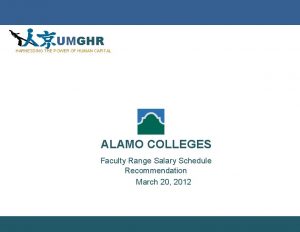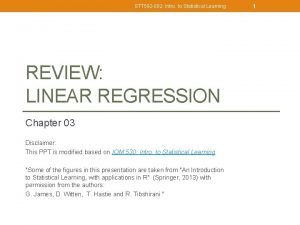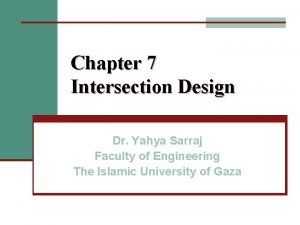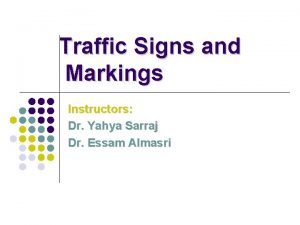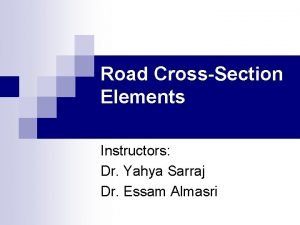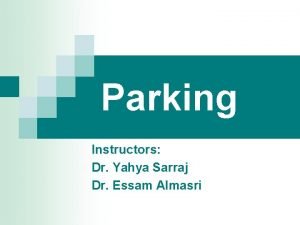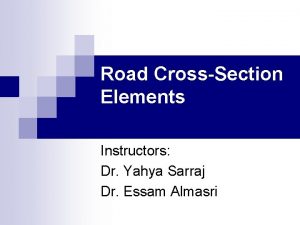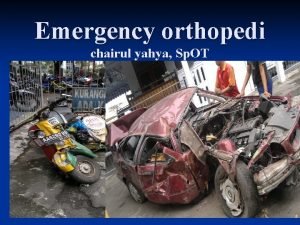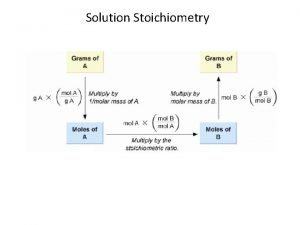Chapter 7 Example Solution Dr Yahya Sarraj Faculty







![Y = [1 - 0. 0345 W] D = [1+0. 094(WB-A – 3. 65)] Y = [1 - 0. 0345 W] D = [1+0. 094(WB-A – 3. 65)]](https://slidetodoc.com/presentation_image_h2/402a8043714b855cbdf7997a7505e691/image-8.jpg)














- Slides: 22

Chapter 7 Example & Solution Dr. Yahya Sarraj Faculty of Engineering The Islamic University of Gaza

6. 4 Priority Intersections Problem n A cross- road intersection is controlled by priority rule. The percent of truck 10%, the grade is 4%. The demand flow in the design year is shown in (Fig 1). n Find the capacity of movements 1, 7, 8, 9. and then n find RFC (Ratio of flow to capacity) n & Comment. (Assume one stage) Fig (1)

n Solution:

n Solution: Assuming one stage

6. 4 Priority Intersections 6. 4. 3 Capacity of T-Intersections Using British Method The capacity of a priority T-intersection is primarily dependent upon: ·The ratio of the flows on the major and minor roads; ·The critical (minimum) gap in the main road traffic stream acceptable to entering traffic; and ·The maximum delay acceptable to minor road vehicles. Empirical research has resulted in predictive capacity equations for T-intersections which where derived from traffic flow measurements and from certain broad features of junction layout. This empirical approach has been adopted by the Department of Transport in Britain.

6. 4 Priority Intersections 6. 4. 3 Capacity of T-Intersections Using British Method A T-intersection has six separate traffic stream (shown in the next figure), of which: · The through streams on the major road (C-A and B-C) and the right-turn stream off the major road (A-B) are generally assumed to be priority streams and to suffer no delays from other traffic; ·While the two minor road streams (B-A and B-C) and the major road leftturn stream (C-B) incur delays due to their need to give way to higher priority streams. Arm A (Major) q. C-A q. C-B q. A-C q. A-B q. B-A q. B-C Arm B (Minor) Arm C (Major)

6. 4 Priority Intersections 6. 4. 3 Capacity of T-Intersections Using British Method The predictive capacity equations for the three non-priority streams are as follows: qs B-A = D{627 + 14 WCR – Y[0. 364 q. A-C + 0. 114 q. A-B+ 0. 229 q. C-A +0. 520 q. C-B]} qs B-C = E{745 – Y[0. 364 q. A-C + 0. 114 q. A-B]} qs C-B = F{745 – 0. 364 Y[q. A-C + q. A-B]} where Y = [1 - 0. 0345 W] D = [1+0. 094(WB-A – 3. 65)] [1+0. 0009(Vl B-A – 120)] [1+. 0006(Vr B-A -150)] E = [1+0. 094(WB-C – 3. 65)] [1+0. 0009(Vl B-C – 120)] F = [1+0. 094(WC-B – 3. 65)] [1+0. 0009(Vl C-B – 120)] WCR = is the average width of the central reserve lane, at the intersection, on a dual carriageway road.
![Y 1 0 0345 W D 10 094WBA 3 65 Y = [1 - 0. 0345 W] D = [1+0. 094(WB-A – 3. 65)]](https://slidetodoc.com/presentation_image_h2/402a8043714b855cbdf7997a7505e691/image-8.jpg)
Y = [1 - 0. 0345 W] D = [1+0. 094(WB-A – 3. 65)] [1+0. 0009(Vl B-A – 120)] [1+. 0006(Vr B-A -150)] E = [1+0. 094(WB-C – 3. 65)] [1+0. 0009(Vl B-C – 120)] F = [1+0. 094(WC-B – 3. 65)] [1+0. 0009(Vl C-B – 120)] WB-A and WB-C = the average widths of each of the minor road approach lanes for waiting vehicles in streams B-A and B-C, respectively, measured over a distance of 20 m upstream from the give Way line (2. 05 – 4. 70 m). WC-B = the average width of the left-turn (central) lane on the major road, or 2. 1 m if there is no explicit provision for left turners in stream C-B (2. 05 – 4. 70 m). . Vl B-A , Vr B-A and Vl B-C = the left and right visibility distances, available from the minor road (22 - 250 m). Vl C-B = the visibility available to left-turning vehicles waiting to turn left from the major road (22 - 250 m). W = the average major road carriageway width at the intersection; in the case of dual carriageways and single carriageways with ghost or raised islands, W excludes the width of the central (turning) lane.

6. 4 Priority Intersections 6. 4. 3 Capacity of T-Intersections Using British Method Consider the following remarks when applying the mentioned method: · All capacities and flows are in passenger car units per hour (pcu/h), and distances are in meters ; · Capacities are always positive or zero, if the right-hand side of any equation is negative, the capacity is taken as zero; · The ranges within which the geometric data are considered valid are: üW = 2. 05 – 4. 70 m, üV r = 22 -250 m, üV l = 17 -250 m, üWCR = 1. 2 -9 m (dual carriageway sites only), üW = 6. 4 - 20 m

0 m a b 5 m 10 m 15 m 20 m c d e

left


a 0 m b 5 m c 10 m 15 m 20 m d e

a 0 m b 5 m c 10 m d 15 m 20 m e

left

W 3 W 1 W 4 W 2

W 3 W 1 W 4 W 2 W 3 W 1 W 5 W 6 W 4 W 2

10 m


left

Example

Answer
 Pak yahya adalah seorang penjaga sekolah
Pak yahya adalah seorang penjaga sekolah Benzeri
Benzeri Hz yahya nerede doğdu
Hz yahya nerede doğdu Yahyanin babasi kimdir
Yahyanin babasi kimdir Mri pulse sequence
Mri pulse sequence Jficm
Jficm Qasim and yahya limited
Qasim and yahya limited Val.meb.k12 batman
Val.meb.k12 batman Bir peygamber tanıyorum hz zekeriya
Bir peygamber tanıyorum hz zekeriya Sheridan and king experiment
Sheridan and king experiment Dr yahya büyükaşık
Dr yahya büyükaşık Azman yahya
Azman yahya Immiscible
Immiscible Herszon kherson maritime college of merchant marine fleet
Herszon kherson maritime college of merchant marine fleet University of bridgeport computer science
University of bridgeport computer science University of bridgeport computer engineering
University of bridgeport computer engineering Alamo colleges faculty salary schedule
Alamo colleges faculty salary schedule Hahnville high school powerschool
Hahnville high school powerschool Importance of faculty in higher education
Importance of faculty in higher education Hubert kairuki memorial university faculty of medicine
Hubert kairuki memorial university faculty of medicine Http://www-bcf.usc.edu/~gareth/isl/advertising.csv
Http://www-bcf.usc.edu/~gareth/isl/advertising.csv Hyperparathyreosis
Hyperparathyreosis Penn state neurosurgery
Penn state neurosurgery



